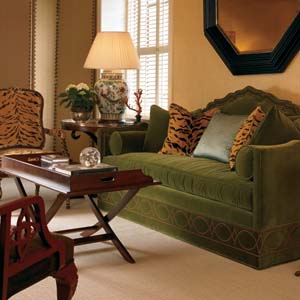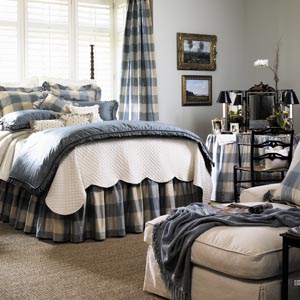 |

If you're confused about fabrics, start with style and pattern and go from there. Photo: Duralee Fabrics

This Venetian Sofa from the Oscar de la Renta by Century Furniture shows that velvet is one home furnishings fabric that never goes out of style.

Chenille has a very soft hand and a plush look. Photo: Thibaut Design

Once reserved for high-end formal apparel, silk fabrics are now frequently used in the home, like the 100% silk taffeta draperies, table skirt, bed skirt and pillow shams shown here. Photo courtesy of Casa Fiora
![pearson-detail[1]-revised](/assets/2009/10/10/pearson-detail[1]-revised.jpg)
Linen, like this 100% linen woven damask, has undergone a surge in popularity for use on upholstery and window treatments. Photo courtesy of Pearson
![thibaut-bow_roomset_550[1]-revised](/assets/2009/10/10/thibaut-bow_roomset_550[1]-revised.jpg)
Outdoor fabrics have exploded in popularity and are now available in a limitless array of colors and patterns. Photo: Thibaut Design
Outdoor fabrics have exploded in popularity and are now available in a limitless array of colors and patterns. Photo: Thibaut Design
Sun-Sensitive Silk
Silk is a fabulous fabric choice for a number of applications. Just remember: It’s very sensitive to light, so silk furnishings may fade in bright conditions, and silk window treatments should be lined.
-
Home Furnishings Fabric Primer
All you need to know about decorative fabrics—from cotton to velvet and everything in between.
- by Nancy Robinson
If you’ve ever shopped for home furnishings fabrics—those made specifically for upholstery, window treatments and other residential interior applications—you know the options are virtually limitless. From pattern and color, to fiber content and construction, if you don’t know what to look for, it’s easy to get lost.
Start with Style
“Consumers are frequently totally overwhelmed by the selection because there’s so much beautiful stuff out there,” says Stacy Senior Allan, marketing director for Thibaut Wallpaper and Fabrics. Her solution? “The first step is deciding what kind of style they want for a room. I always tell people to start by clipping a bunch of pictures they like from magazines to decide on the mood they’re going for. Then I suggest they find one main fabric that they just love. From there, they should pick coordinates, mixing prints and wovens.”
Construction Close Up
To simplify the task of exploring and comparing your options, it’s helpful to consider how manufacturers organize their fabric books. Although many books are organized by collection and/or color, swatches are often placed together depending on whether they are prints or wovens. In addition, some fabric books are devoted to a single category: cotton, linen, silk, chenille, outdoor/high performance, etc. With that in mind, here’s a look at basic fabric types and their key characteristics.
Silk
Once reserved for high-end formal apparel, silk fabrics are now frequently used in the home—especially for window treatments, table skirts and bedding accents such as dust ruffles and pillow shams. Good quality silks can also be used for upholstery. Like cotton, linen and wool, silk is a natural fiber, but one with a very rich appearance. It is dimensionally stable and has superior dye acceptance. On the downside, silk is very sensitive to light, so silk furnishings may fade in bright conditions, and silk window treatments should be lined.
Linen
Made from natural flax fibers, linen is one of the oldest yarns known to man. Recently, linen has undergone a surge in popularity for use on upholstery and window treatments primarily due to its subtle, organic yet lustrous appearance. Linen is extremely strong and durable. On the downside, the fabric has little resilience and wrinkles easily.
Cotton
Another essential natural fiber, cotton is a mainstay in home furnishings. In fact, it’s the fabric of choice for many interior applications, including window treatments, upholstery and bedding. The reason: It’s soft, absorbent, durable and has excellent resistance to pilling and abrasion. Cotton also accepts dyes and special finishes extremely well, making it an excellent base cloth, especially for prints. Basic cotton weave types include chintz (and glazed chintz), canvas and twills.
Chenille
Chenille is a popular upholstery fabric best known for its sumptuous softness. Woven from novelty yarns that have a fuzzy surface, chenille is very soft hand and a plush look. Because it’s so comfortable and tends toward the casual side of the design spectrum, it’s a frequent choice for use in family living areas.
Matelasse
A double-woven cloth distinguished by a single-color embossed pattern that simulates a quilted effect, matelasse has a comfortable, informal look. It also has a soft hand especially after washing, making it a favorite fabric for bedding, particularly coverlets and quilts.
Velvet
An elegant and sophisticated choice for upholstery and window treatments, velvet is one home furnishings fabric that never goes out of style. It has recently received renewed attention from fabric designers, resulting in fresh, updated looks. In addition to unique new color palettes, it’s now possible to find printed and striped upholstery velvets as well cut, crushed and panne (high luster) variations.
Damask
Another home furnishings classic, damask is a single layer fabric distinguished by a reversible design created from contrasting dull and satin areas. Damasks can be woven from all types of yarns, including linen, rayon, chenille, silk, etc. Like velvet, damask has been rethought and recast in recent years to give it a more modern look. Today’s designers are blowing up damask frames to make them even more contemporary.
High Performance/Outdoor
Until recently, these overachieving fabrics were relegated to the outdoors because of their resistance to stains, fading, mildew, and harsh outdoor environments. However, the newest generation of these fabrics offers all of these attributes and more. Most notable is the improved hand (softness to touch) as well as patterns and color palettes that mimic high-end indoor residential fabrics. This makes it possible to get stylish, high performance fabrics that look and feel great, while resisting the ravages of muddy paws, messy kids and everyday living.
Microfibers
Another type of high performance residential fabric is in a category all its own: microfibers. These high tech fabrics have a look and feel so much like suede that only upon close inspection do you realize they aren’t the real thing. Most of these fabrics also offer superior stain resistance—making them ideal for households with children and pets.

